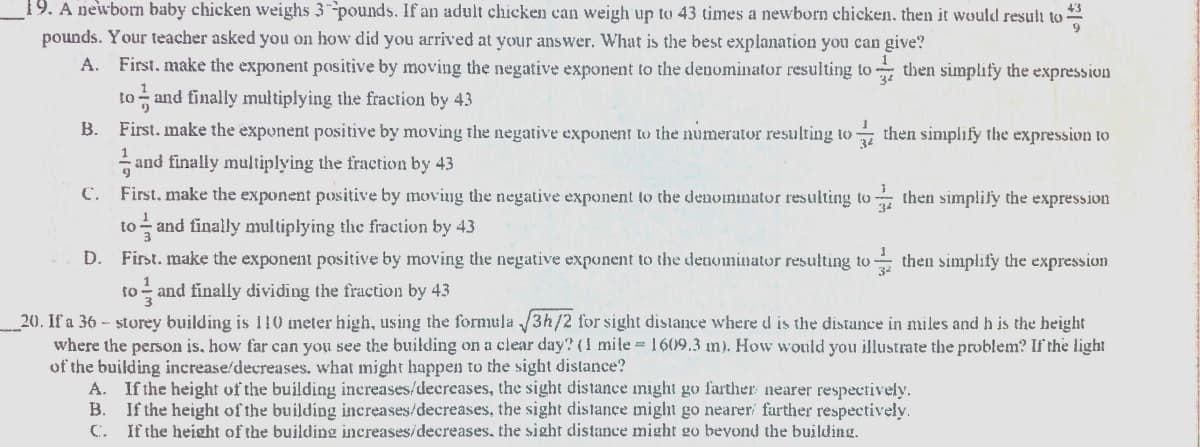19. A newborn baby chicken weighs 3 pounds. If an adult chicken can weigh up to 43 times a newborn chicken. then it would result to 43 pounds. Your teacher asked you on how did you arrived at your answer. What is the best explanation you can give? A. First. make the exponent positive by moving the negative exponent to the denominator resulting to then simplify the expression to and finally multiplying the fraction by 43 B. First. make the exponent positive by moving the negative exponent to the numerator resulting to then simplify the expression to and finally multiplying the fraction by 43 C. First. make the exponent positive by moving the negative exponent to the denoninator resulting to then simplify the expression to and finally multiplying the fraction by 43 D. First. make the exponent positive by moving the negative exponent to the denominator resulting to then simplify the expression to and finally dividing the fraction by 43
19. A newborn baby chicken weighs 3 pounds. If an adult chicken can weigh up to 43 times a newborn chicken. then it would result to 43 pounds. Your teacher asked you on how did you arrived at your answer. What is the best explanation you can give? A. First. make the exponent positive by moving the negative exponent to the denominator resulting to then simplify the expression to and finally multiplying the fraction by 43 B. First. make the exponent positive by moving the negative exponent to the numerator resulting to then simplify the expression to and finally multiplying the fraction by 43 C. First. make the exponent positive by moving the negative exponent to the denoninator resulting to then simplify the expression to and finally multiplying the fraction by 43 D. First. make the exponent positive by moving the negative exponent to the denominator resulting to then simplify the expression to and finally dividing the fraction by 43
Algebra & Trigonometry with Analytic Geometry
13th Edition
ISBN:9781133382119
Author:Swokowski
Publisher:Swokowski
Chapter1: Fundamental Concepts Of Algebra
Section1.2: Exponents And Radicals
Problem 92E
Related questions
Question

Transcribed Image Text:19. A newborn baby chicken weighs 3 pounds. If an adult chicken can weigh up to 43 times a newborn chicken, then it would result to
pounds. Your teacher asked you on how did you arrived at your answer. What is the best explanation you can give?
A. First, make the exponent positive by moving the negative exponent to the denominator resulting to then simplify the expression
34
to - and finally multiplying the fraetion by 43
B. First. make the exponent positive by moving the negative exponent to the numerator resulting to then sinmplify the expression to
and finally multiplying the fraction by 43
C. First. make the exponent positive by moving the negative exponent to the denominator resulting to then simplify the expression
and finally multiplying the fraction by 43
to
D. First. make the exponent positive by moving the negative exponent to the denominator resulting to then simplify the expression
to - and finally dividing the fraction by 43
20. If a 36 - storey building is 110 meter high, using the formula /3h/2 for sight distance where d is the distance in miles and h is the height
where the person is, how far can you see the building on a clear day? (1 mile = 1609.3 m). How would you illustrate the problem? If the light
of the building inerease/decreases. what might happen to the sight distance?
A. If the height of the building inereases/decreases, the sight distance might go farther nearer respectively.
В.
If the height of the building increases/decreases, the sight distance might go nearer farther respectively.
C. If the height of the building increases/decreases, the sight distance might go bevond the building.
Expert Solution
This question has been solved!
Explore an expertly crafted, step-by-step solution for a thorough understanding of key concepts.
Step by step
Solved in 2 steps with 2 images

Recommended textbooks for you

Algebra & Trigonometry with Analytic Geometry
Algebra
ISBN:
9781133382119
Author:
Swokowski
Publisher:
Cengage

Algebra: Structure And Method, Book 1
Algebra
ISBN:
9780395977224
Author:
Richard G. Brown, Mary P. Dolciani, Robert H. Sorgenfrey, William L. Cole
Publisher:
McDougal Littell

College Algebra
Algebra
ISBN:
9781305115545
Author:
James Stewart, Lothar Redlin, Saleem Watson
Publisher:
Cengage Learning

Algebra & Trigonometry with Analytic Geometry
Algebra
ISBN:
9781133382119
Author:
Swokowski
Publisher:
Cengage

Algebra: Structure And Method, Book 1
Algebra
ISBN:
9780395977224
Author:
Richard G. Brown, Mary P. Dolciani, Robert H. Sorgenfrey, William L. Cole
Publisher:
McDougal Littell

College Algebra
Algebra
ISBN:
9781305115545
Author:
James Stewart, Lothar Redlin, Saleem Watson
Publisher:
Cengage Learning

Mathematics For Machine Technology
Advanced Math
ISBN:
9781337798310
Author:
Peterson, John.
Publisher:
Cengage Learning,
